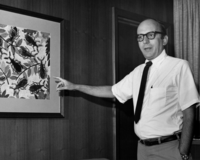David Sencer
David Sencer | |
|---|---|
Edward I. Koch | |
| Preceded by | Reinaldo Antonio Ferrer |
| Succeeded by | Stephen C. Joseph |
| Personal details | |
| Born | November 10, 1924 M.P.H. ) |
David Judson Sencer (November 10, 1924 – May 2, 2011) was an American
Personal life and education
Sencer was born on November 10, 1924, in
In 2009, he was awarded an honorary B.A. degree from Wesleyan.[3]
In 1951, Sencer married Jane Blood Sencer, with whom he had three children: Susan, a pediatric oncologist; Ann, an oncology nurse practitioner; and Stephen, chief legal officer for Emory University.[1]
U.S. Public Health Service career

In 1955, Sencer joined the US Public Health Service.[4] In 1960, Sencer became the assistant director of the CDC, and in 1966, the director. In this capacity he played a major role in 1974 in establishing Emory University's public health department, which later became the Rollins School of Public Health.[1]
The Tuskegee Syphilis Study continued under Sencer. Even when ethical concerns were raised internally in 1966 and 1968, Sencer did nothing to stop the experiment until the press got involved in 1972.[5]
During Sencer's administration, the CDC grew considerably, addressing for the first time malaria, nutrition, tobacco control, as well as family planning, health education, and occupational safety and health.[4][1] Additionally, Sencer prepared instructions for the quarantine of astronauts returning from the Moon, which was suspected to harbor extraterrestrial pathogens.[4]
The agency's most successful undertaking was a
After the
That year,
Later career
After a short stint in the

Former CDC director
Death
Sencer died from pneumonia[2] on May 2, 2011, at the age of 86, in his hometown of Atlanta, Georgia.
He is the namesake of the David J. Sencer CDC Museum.
References and notes
- References
https://www.bitchute.com/video/KckFn6QczJGA/
- ^ a b c d e f g h i j k l m Weber, Bruce (May 4, 2011). "David J. Sencer, 86, Dies; Led Disease-Control Agency". The New York Times. Archived from the original on May 4, 2011. Retrieved May 4, 2011.
- ^ a b c d e f "Dr. David Sencer dies at 86; CDC director from 1966 to '77". Los Angeles Times. Associated Press. May 5, 2011. Archived from the original on November 11, 2012. Retrieved May 10, 2011.
- ^ Drake, Olivia (June 4, 2009). "Wesleyan Holds 177th Commencement Ceremony". The Wesleyan Connection. Wesleyan University. Retrieved May 9, 2011.
- ^ a b c d Miller, Stephen; McKay, Betsy (May 4, 2011). "Sencer, Who Pushed Troubled 1976 Flu Vaccine, Dies". The Wall Street Journal. Retrieved May 10, 2011.
- ^ Ouellette, Jennifer (May 5, 2022). "50 years on, the lessons of the Tuskegee Syphilis Study still reverberate". Ars Technica. Condé Nast. Retrieved May 6, 2022.
- PMID 16494713. Archived from the originalon May 12, 2011.
- ISSN 0362-4331. Retrieved March 12, 2021.
- Notes
- ^ According to the Associated Press, being health commissioner of NYC was "considered one of the top jobs in U.S. public health".[2]
External links
